We may earn revenue from the products available on this page and participate in affiliate programs. Learn More ›
Q: My garden is abuzz with hummingbirds every summer, yet I rarely see hummingbirds feeding or nesting in my yard during other seasons. Where do hummingbirds live the rest of the year?
A: Despite their miniature size, most species of hummingbirds migrate in the fall and spring, just as other birds do. In autumn, migratory hummingbirds leave North America and travel south where they winter from southern Mexico to Central America. In spring (a.k.a. breeding season), hummingbirds move north. Their migration tracks with the blooming of nectar-rich flowers, which hummingbirds rely on for up to 90 percent of their diet, according to the National Audubon Society.
It’s possible that hummingbirds stop by your yard in spring as they journey to their breeding grounds, but you may not notice their presence unless they’re nesting in nearby trees. Early summer is a peak time of activity for hummer sightings. By this time in the year, juvenile hummingbirds have “fledged” or left the nest; with higher hummingbird populations flitting around, the likelihood of glimpsing one of these avian gems increases, too.
Keep reading for a more detailed look at where hummingbirds live while migrating and nesting, as well as a few tips for encouraging these tiny creatures to call your yard or garden “home” during both of these periods.
Hummingbirds begin migrating to the US in March.
During spring migration, hummingbirds start to visit flowering plants and nectar feeders within the United States anywhere from March to May. How early (or late) they arrive varies from region to region.
- In the eastern US, the Ruby-throated Hummingbird typically arrives along the Gulf Coast by early March. By late April and early May, Ruby-throats will have journeyed into the northern states and also into the southern provinces of Canada.
- In the central US, hummers typically appear near Mexican border states in early March. By mid-May, these itty-bitty birds have expanded their range into the Rocky Mountains.
- In the western US, some species of hummingbirds, including Anna’s and Allen’s hummingbirds, are present year-round. Species that do migrate to this region, such as the copper-colored Rufous, may appear in late-February.
Hummingbirds live in camouflaged nests.
Once hummingbirds reach their North American breeding grounds, females busy themselves with building nests. Chances are high that you won’t ever see these. Besides being roughly the size of a walnut shell, hummingbird nests are located on the horizontal branches of deciduous trees and large shrubs (often where adjoining branches form a “fork”) tens of feet above ground. Due to their positions, these hummingbird homes are well hidden by an umbrella of leaves during the spring and summer months. What’s more, hummingbirds cover their nests—which are made of grasses, plant fibers, and spider webs—with lichens and dead leaves, which make nests look like mere bumps on a knobby branch.
As far as which trees and shrubs make the best homes, hummingbirds aren’t picky. As long as a nesting site offers the above protections, hummers will nest in a variety of habitats, including forests, woodland edges, yards, gardens, and parks and greenspaces.

Attract hummingbird passersby with showy flowers, water features, and perches aplenty.
One of the best ways to encourage more hummers to take respite or nest in your yard is with nectar. Due to their high metabolism, hummingbirds must eat once every 10 to 15 minutes, according to the National Audubon Society. Planting brightly-hued, tubular-shaped flowers (bee balms, honeysuckles, columbines, sages, and more) will invite hummingbirds for a snack. In addition to planting flowers, nectar feeders provide extra nutrition for hummingbirds. Fill feeders with a simple syrup solution (four parts water to one part white sugar, boiled for 1 to 2 minutes, then cooled) and change the sugar water once or twice weekly to keep it fresh.
Although they drink nectar, hummingbirds still require plain water both for drinking and bathing. Bird bath fountains and water features with misters are best, since they provide sprinkles of water to hydrate yet not overwhelm tiny hummers.
Hummingbirds also need safe places to rest, sleep, and survey their territory. A diversity of leafy trees and shrubs in your yard will provide the shelter hummingbirds need to be able to feel protected.
Take down hummingbird feeders after the first frost of fall.
Hummingbirds begin fall migration as early as August, so you’ll likely notice fewer visitors in late-summer. Even so, it’s best to keep feeders stocked with fresh sugar water through early fall. This provides a food source for stray migrants and species such as Rufous that are better adapted to cool temperatures and thus tend to linger later into the fall season. A good rule of thumb: Take down feeders when the first frost/freeze occurs, or when minimum air temperatures dip near or below 32 degrees Fahrenheit. Migratory hummingbirds are only able to survive cold for short periods of time, so they have likely left the area once temperatures drop this low.
In winter, hummingbirds travel south to warmer climates.
While a few species of hummingbirds remain in California and south Florida year-round, the majority migrate to warmer latitudes during the fall and overwinter in locations from Mexico to Costa Rica.
















